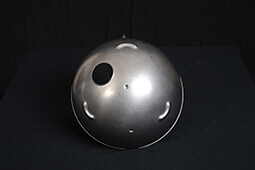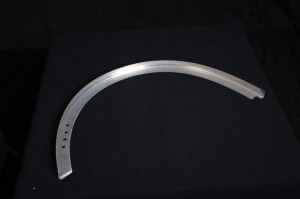How Do I Form This Part?
How Do I Form this Part
To form your part in the most efficient and cost-sensible way, you need the right metal forming process. This begins with an assessment of your ideal final product. Today, we’ll look at a frame section from the aerospace industry as an example, and how it was formed at Jones Metal Products.
This product features many elements that make it ideal for fluid cell forming, a type of hydroforming. Fluid cell forming uses a fluid cell press, or bag press, to form blank sheet metal into a specific shape. This frame element has a complicated design, which would make it an unlikely candidate for a process like metal stamping. While stamping is ideal for simple parts or large volume productions, complex design challenges can be easily met using fluid cell forming. If you look at the image, you’ll see that the frame has an inverted lip, curvature, and holes. Fluid cell forming uses pressures of up to 11,600 p.s.i. to ensure that these complicated elements are formed correctly. And because the process is done with fluid pressure against a rubber diaphragm, the final product has a better finish and fewer abrasions than other methods.


Jones Metal Products was the first contract manufacturer in the United States to offer fluid cell forming. Now, small and mid-sized manufacturers can benefit from the same high caliber flexibility and productivity. This process can be an efficient option, especially if a business has multiple parts to form. With fluid cell forming, more than one part can be formed in the same tray. This lowers the tooling costs as well as improving the speed of overall production.
Another consideration for forming your part is the metal you will use. Here, our aerospace frame was formed from aluminum. Other possible metals that can be fluid cell formed are titanium and stainless steel.
To conclude, here is a checklist of metal forming assessments to consider:
- Order size – If you have a large order of simple parts, you may consider metal stamping. If your order includes more complex parts, fluid cell forming or hydroforming may be better options.
- Product finish – If your product is not visible in its final application or if a polished finish is not a necessity, then stamping may be an effective method. If your product needs to have minimal scuffs and scratches, a fluid based forming process will yield better results.
- Material – Some of the most frequent metals requested to be formed at Jones Metal Products are aluminum alloys, titanium, and stainless steel. However, we work with many types of metals and will work to fit your product needs.
- Secondary Processes – Jones Metal Products performs many of its work in-house. If your product needs additional processes such as powder coating, Jones Metal Products can point you in the right direction.
For more information about our services, or to talk about your part forming needs with one of our experts, contact us or call 888-479-9566.
